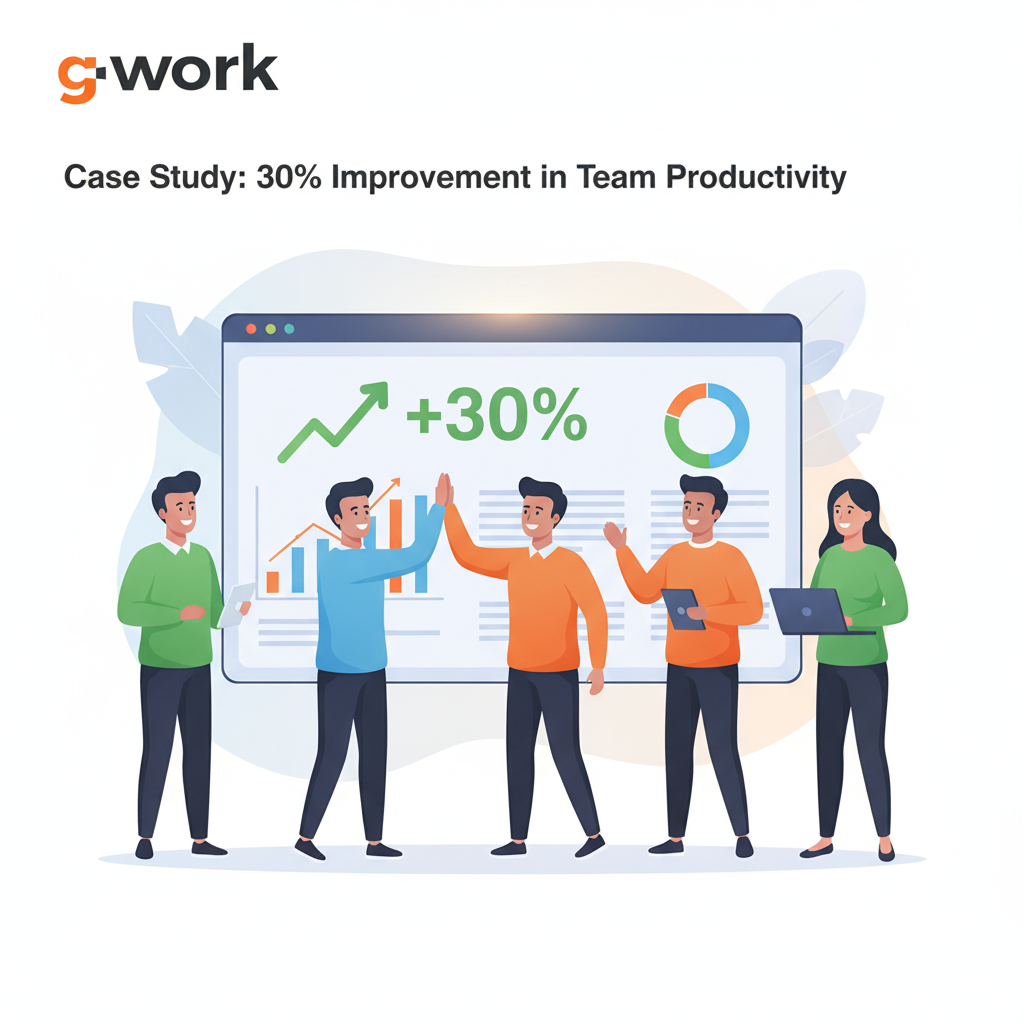The enhancement of the team performance does not always presuppose extensive systems or costly training programs. And, at times, minor changes have the greatest influence. One of such techniques, which are simple but effective, is Habit Nudges. They assist teams to appear more solid, pursue objectives and accountability of their actions on daily basis.
This blog discusses how habit nudges make work more accountable and help change behavior in the long-run at work. You will also get to learn practical tips that you can start applying now and how Gwork simplifies it to the easiest ever.
What Are Habit Nudges?
Habit Nudges refer to brief motivating actions. They do not impose the correct decision but direct people. Habit Nudges at the workplace keep staff members in mind to accomplish duties, interact effectively, and develop effective routines.
Examples include:
- A reminder alerting a team member to make progress
- A notification that promotes a quick checklist review within a deadline
- An incentive to recognize goals that are achieved
- Courteous prompting to adhere to the conventional procedures in a workflow
Habit nudges are not rules or punishment-related tools. They labor since they help to maintain good habits not to regulate them. They demonstrate the next step and simplify the doing of the already desired things by employees.
In comparison to one-time feedback, nudges are regular. They hold the right behaviours to be visible in their daily work and this is what forms habits.
This is a straightforward method of enhancing performance since minor improvements accumulate quickly when it includes the whole team.
Why Habit Nudges Improve Workplace Accountability
Workplace responsibility is regarding the performance of actions, doing what is expected, and follow through. Accountability is a challenge to teams that lack it. Activities become latent, communication is hampered and objectives are lost.
The Habit Nudges approach this difficulty optimistically and effectively.
1. They reinforce responsibility
The employees are given the right reminder at the right time. They do things instead of forgetting to do the tasks. This develops a high degree of trust.
2. They prevent problems before they grow
An alert given prior to the deadline prevents work absenteeism. Habit nudges help managers reduce the pursuits of employees later.
3. They make accountability fair and consistent
All people receive equal assistance. Nudges involve substituting micromanagement with an employee-empowering system.
4. They increase visibility
Team members and managers remain on track. Evident improvement enhances confidence and builds cooperation.
5. They reduce stress
When we understand what to do next, we feel more confident of what we are doing. Less anxiety implies higher performance.
Habit Nudges create a culture in which doing the right thing is a natural thing. The outcome: accountability is included in the working process.
How Habit Nudges Support Behavior Change at Work
Change in behavior in the workplace will demand repetition. Humans require time and regularity to develop new habits. This is why grandiose announcements or single workshops do not last long.
The solution to this is provided by Habit Nudges, which appear repeatedly.
1. Small actions → strong habits
A reminder of the progress to be made each morning is a shaper of a routine. An immediate adherence to the best practices enhances quality. These micro-behaviors become automatic with time.
2. Positive reinforcement creates motivation
Winning motivates one to win. An instant, straightforward message raises morale and activity to a higher level than the delayed appreciation.
3. They reduce friction
Everyone is on board when change of behavior comes easy. Nudges eliminate extraneous processes and get people directly to business.
4. They help new employees fit in faster
The way of behavior in work is acquired through practice. Habit Nudges assist the new employees to embrace the standards of the team promptly and with confidence.
5. They align actions with company goals
Nudges put the priorities in the forefront of employees instead of relying on their memory.
That is why the continuous improvement of companies with nudging systems is observed. It takes little things done daily to result in a fruitful future.
6. Practical Habit Nudges Your Team Can Start Today
These are just some of the nudges that teams will like and embrace:
1. Daily focus reminders
Every morning, the employees get a text message notifying them about the critical activities. This assists them in getting on better footing and not procrastinating.
2. Deadline nudges
Remembering about work before hand saves one the last-minute scramble.
3. Progress check-ins
When it comes to asking about the status, you want to ask: What is your status? This will make everyone be on track.
4. Checklists for quality
A short list nudge will assist the employees in giving work which is consistent and comprehensive.
5. Meeting preparation prompts
It reminds the teams to have an efficient and productive meeting by reminding them to go through the agenda.
6. Recognition nudges
A reward that commemorates the accomplishment or attainment of given tasks or activity develops motivation and good morale.
7. Peer encouragement prompts
Positive prods build teamwork and responsibility within coworkers.
8. Personal development reminders
Timely completion of a learning task contributes to the long-term skill development.
9. Health and balance nudges
Burnout can be avoided by using short messages to remind people to take a break and enhance concentration.
These nudges do not need much effort to establish – but produce a significant payoff in team performance.
Habit Nudges in Different Workplace Scenarios
The Habit Nudges are quite versatile and can work with numerous types of work:
1. Project management
- Track milestones
- Prevent delays
- Keep collaboration smooth
2. Sales and customer success
- The follow-ups are regular
- Outreach improves
- There is improved service to customers
3. IT and engineering
- Updates of tickets are not hidden
- Best practices are maintained
- Quality improves over time
4. Operations and logistics
- Normal processes are carried out uninterrupted
- Duties are fulfilled within time
- Workplace safety improves
5. HR and onboarding
- Recruits develop good working habits fast
- Reminders on policy make people obey
Habit nudges enhance productivity and responsibility across all departments.
Why Habit Nudges Are Better Than Micromanagement
Managers desire excellent outcomes. They desire employees to assume responsibility without having them under strict supervision all the time.
1. They give autonomy
Employees choose to act — nudges don’t pressure or demand.
2. They reduce awkward conversations
A manager does not need to ask again and again, just a simple prompt is enough.
3. They create consistency
A nudge never fails to make a follow-up.
4. They strengthen trust
The workers do not feel monitored, but assisted.
5. They promote learning
Good habits are developed by small, repeated habits rather than fear and stress.
Managers guide. Nudges remind. Teams succeed.
How Habit Nudges Build a High-Performance Culture
Success is not one big moment. It is the total of all the little things.
Habit nudges support action that builds a powerful workplace culture:
- Active responsibility rather than blame
- Proper communication rather than misunderstanding
- Concentration rather than distractions.
- Team relationship rather than loneliness
Employees take responsibility of work. They support each other. They steer in the direction of common interests.
This establishes a culture where performance is good not compulsory.
How Gwork Turns Nudges into Results
Habit Nudges made by Gwork appear easy. The platform provides intelligent hints at the most appropriate moment guiding employees to meaningful action every day.
What Gwork does best:
- Leaves automatic reminders to keep important things on track
- Promotes regular exercises that enhance performance
- Favors staff responsibility but does not micromanage
- Assists teams in real-time communications
- Positive-rewarding behavior change
- Enhances inter-departmental cooperation
- Provides managers with clear visibility (up to date)
Using Gwork, teams do not have to keep all steps in mind. The system gives them ease of direction through basic indicators which translate to improved results.
CTA: Start building productive habits with Gwork today and boost your team performance using smart Habit Nudges.
Gwork was constructed to ensure that accountability was simple and pleasurable. Whenever individuals have the backing, they present themselves optimally.
Tips for Successfully Implementing Habit Nudges
To ensure that your team embraces nudges within a short time, remember the following points:
1. Keep nudges short
Long instructions are often not good as a few words.
2. Deliver nudges at the right moment
Timing is what makes people either act or not.
3. Focus on behavior, not punishment
Pressure never does the trick as encouragement does.
4. Celebrate progress
Recognition nudges are pleasant and increase morale.
5. Adapt and personalize
Various roles should be provided with different nudges.
6. Track results
Measure improvement using clear measures.
7. Ask for feedback
Employees assist in perfecting what is best.
The idea is to make nudges seem like useful colleagues to the team – not additional work.
The Future of Workplace Accountability with Habit Nudges
Organizations are adopting wiser methods of enhancing performance. Habit Nudges are self-scalable, social, and based on behavioral science.
Nudges will increasingly become important in: work that is increasingly digital and collaborative.
- Hybrid team communication
- Learning and development
- Performance management
- Mental health and well-being
- Ongoing improvement programs
Those companies that embrace Habit Nudges today have an upper hand. Their teams develop good habits at a rapid pace. They stay more agile. They attain objectives with a sense of surety.
The tools such as Gwork are transforming the workplace for the better—one good step at a time.
Conclusion
Habit Nudges simplify work, streamline it, and hold it more responsible. They endorse behavior change, enable teams to take ownership of their behavior and improve relationships at the workplace. When one receives the correct reminder at the appropriate time, then improvement will become a routine.
You want your team to be more productive, consistent, and engaged, but you need to be aware of a secret of Habit Nudges. And to Gwork, you can begin today, without the stress, complexity, and pressure.
Minor reminders bring significant outcomes. High performance is a process that is constructed habit by habit.
Frequently Asked Questions (FAQs)
1️. What are habit nudges at work?
Habit nudges are brief notifications, which assist workers to keep up with work, habits, and duties. They do not coerce people to do good things but nurture their behavior. The nudges facilitate work productivity, accountability, and follow up.
2️. How do habit nudges improve workplace accountability?
Tasks are reinforced by Habit Nudges. Whenever an individual is reminded on the appropriate time, he/she will find it easier to finish the task and report progress. This minimizes time wastage, lack of understanding, and builds confidence in the team.
3️. Are habit nudges the same as micromanagement?
No. Micromanagement puts strain and lessens authority. Habit nudges do the opposite. They provide the employees with the necessary support and leave them at liberty. Individuals are empowered as opposed to being controlled.
4️. Can habit nudges really drive behavior change at work?
Yes. Behavior change occurs when one takes little actions, which are repeated. Habit nudges are used to make employees develop a routine and concentrate. They make good intentions good habits that enhance performance in the long run.
5️. What types of reminders work best in a workplace?
Successful reminders are brief, direct and goal oriented. The common ones are cues on daily tasks, cues on deadlines, cues to review the progress, and cues about quality steps. Nudges are also positive recognition nudges that aid motivation and teamwork.
6️. How does Gwork use habit nudges to help teams?
Gwork sends smart, automated nudges that guide employees toward the right action at the right moment. It improves performance by:
- Supporting accountability
- Encouraging progress updates
- Reducing task delays
- Helping teams build strong habits
Managers gain visibility, and employees feel supported — not overwhelmed.
7️. Do habit nudges work for remote or hybrid teams?
Definitely. Distributed teams rely on the digital communication. Habit nudges ensure that all people are in sync and in contact even when they are not together. They ensure that work does not get through the cracks.
8️. How fast can teams see results with Habit Nudges?
Most of the teams see improvements in a few weeks. Performance also improves as the routines become stronger. Minor, repetitive interactions become future culture.
9️. Can habit nudges support employee well-being too?
Yes. Notifications to have a rest, balance workloads, and congratulate achievements will alleviate stress and make the working environment healthier.
10️. How can my organization get started with Habit Nudges?
Simple nudges associated with important objectives are a place to start. In order to roll out successfully with minimal difficulties, Gwork offers automated nudges that are specifically tailored to hold employees accountable and encourage behavior change in the workplace.











